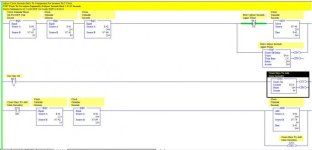I have an application that requires the correct time controlling of some outputs, but during testing have discovered the SLC 5/03's clock looses a few seconds each day (unacceptable for this application). To compensate I added a line adding a few seconds just after Midnight hoping this will be close enough, but was wondering:
Is there a tweak to the clock speed on a SLC?
Is there an easy way for the SLC to read the real time on the PC based HMI at regular intervals? (Using DF-1 serial comm's) (1747-L532C 5/03 OS302)
Is there a tweak to the clock speed on a SLC?
Is there an easy way for the SLC to read the real time on the PC based HMI at regular intervals? (Using DF-1 serial comm's) (1747-L532C 5/03 OS302)



